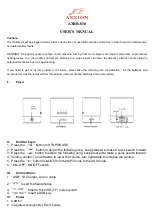
er, so you must connect the wire from the
amplifier to the volume control and then
from the volume control to the speaker.
Speaker Wire
Use 2-conductor speaker wire when con-
necting PR speakers to your receiver or
amplifier. For most applications, we rec-
ommend you use 16 or 18 gauge stranded
wire. For wiring runs longer than 80 feet
(25 meters) we recommend 14 gauge
stranded wire. When you run wire inside
walls, special jacketing (CL-2 or CL-3) is
required to both protect the wire and for
fire prevention. In some areas conduit
is required. For a trouble-free installa-
tion, low voltage wire such as speaker
wire must be run in accordance with the
National Electrical Code and any applica-
ble provisions of the local building code.
If you are unsure of the correct installation
techniques, wire jacket or type of conduit
to use, consult a professional audio/video
installer, your building contractor, or the
local building and inspection department.
Incorporating a Remote Control
If you are planning to use a stereo system
with a hand held IR remote control, con-
sider the advantages of installing a Niles IR
Repeater system. You are able to control
all of the functions of your system from
the room via the remote pair of speakers.
Niles makes a number of IR sensors which
install in the wall, in the ceiling, in cabine-
try, on tabletops, or even behind the grille
of some of your Niles speakers.
An IR sensor requires that a 2-conductor
shielded wire (West Penn D291 or equiv-
alent) be home run from each sensor loca-
tion to the main equipment location. This
wire is normally run beside the speaker
wire at the same time. Typically, the sen-
sor is placed in a location that faces your
listening position. Most remote controls
will have an effective line of sight range of
18 to 30 feet (6-10 meters) with any Niles
sensor placed in a wall, ceiling, on a cabi-
net or tabletop. However, when you place
a Niles MS110 MicroSensor behind the
perforated aluminum grille of a speaker
the effective range is reduced to 9 to 15
feet (3-5 meters).
Insulating the Wall Cavity
For best performance from your speakers
fill the wall cavity behind the speaker with
fiberglass insulation (e.g. R-19 unbatted
insulation). Try to keep the same amount
of insulation for each speaker, particu-
larly in the same room, for consistent
bass response.
5
Installation Considerations
TECH TIP
Wire size is expressed by its AWG (American Wire
Gauge) number. The lower the number, the larger
the wire, i.e. twelve AWG is physically larger than
fourteen AWG.
6
Speaker Placement
Placement for Critical Listening
If you like to imagine that the band or
orchestra is playing in front of you as you
listen to music, or you are very conscious of
clarity, detail and the textures of the individ-
ual instruments, you are a critical listener.
In a home theater, the intelligibility of
dialog and action reproduced by the front
speakers is paramount! The position of
the speakers plays a very important role in
how clear the sound is and how a stereo
image is created. Here are some guide-
lines to make the process of placement
quick and easy.
Make sure the sound will not be blocked
or reflected off of furniture or other objects.
You should have a direct line of sight with
the front of the speaker. To determine the
best position, measure the “listening” dis-
tance between the ideal listening position
(your favorite chair or couch) and the wall
in which you plan to install the speakers.
Try to place the speakers so that they are
equally distant from your listening spot
and at least one half of the listening dis-
tance apart (this maintains a large pleasant
stereo “image”). In home theater applica-
tions where there is a center channel you
may choose to space the left and right
main speakers farther apart for a “bigger
than life” sound with Dolby
®
encoded
movies and TV shows. However, for com-
bined music and movie usage stay within
the
good placement zone
for music. For
example; if you are ten feet back from the
wall, the speakers should be between five
and ten feet apart
(See Figure 2)
.
Speaker Placement
Speaker
Placement
Zone
Speaker
Placement
Zone
10’
(3 meters)
5’
(1.7 meters)
Figure 2
10’
(3 meters)































